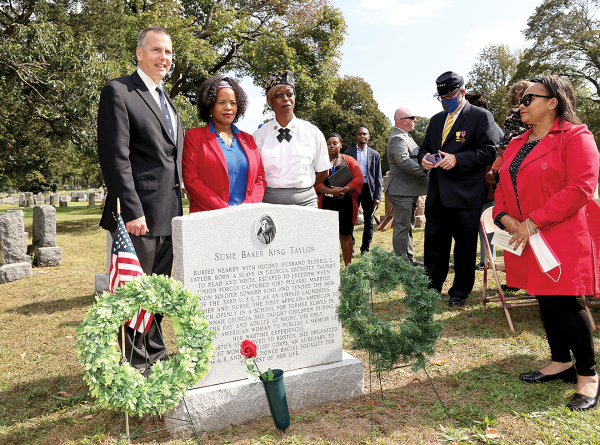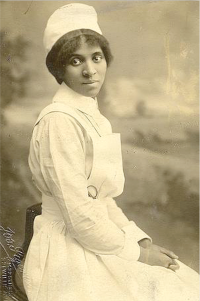February 22, 2024

Former Boston Mayor Kim Janey presided at a ceremony to dedicate a new memorial stone for Susie King Taylor at her burial site inside Mount Hope Cemetery in Mattapan in 2021. Janey is flanked here by Roderick Fraser of The Sons of Union Veterans Civil War, left, and Mary-dith Tuitt, commander of the William E. Carter American Legion Post 16.
Photo courtesy John Wilcox/Mayor’s Office

Susie King Taylor led a remarkable life. Born into slavery in ante-bellum Georgia, she served as a Union Army nurse, caring for wounded and dying soldiers in the Civil War, although she was never properly compensated for her work. She learned to read and write by attending secret schools and went on to help others to do the same. Later, she became the first Black woman to self-publish a memoir of her wartime experiences.
Yet, despite her many accomplishments, Taylor is a footnote to history here in Boston, where she lived in her later years. In Mattapan’s Mount Hope Cemetery, where she was laid to rest in 1912, her grave marker identified her husband, but listed her only as “Mrs. Taylor.”
All of which did not sit well with Mary-dith Tuitt, a US Navy veteran who serves as commander of the William E. Carter American Legion Post 16 on Blue Hill Avenue.
“As a woman, you know that’s what happens to us, we are always put on the back burner. To know that she was just buried as the wife of Mr. Taylor and nothing else, wasn’t a surprise,” said Tuitt, who worked with others to rectify the cemetery injustice. In October 2021, she was on hand when Mayor Kim Janey unveiled a new grave marker that gives the highlights Taylor’s life.
By doing that they said they hope that more Bostonians will remember the sacrifices of Black Americans who fought to preserve the Union and end slavery.
“There were 200,000 black soldiers in the Union Army during the Civil War and a lot of people who live in the Commonwealth, who are African American, have African American Civil War Union soldiers as their ancestors, might not even know that,” said Roderick Fraser, a leader of the Massachusetts chapter of The Sons of Union Veterans Civil War (SUVCW). “These soldiers contributed just as much as anyone else.”
It was Fraser who brought the forgotten story of Susie King Taylor to Tuitt’s attention. Veterans who belong to the Carter Post take special care of burial plots at Mount Hope Cemetery and participate in Memorial Day observances there.
Fraser told Tuitt that he’d located Taylor’s grave, but was shocked that there was no recognition at the site of what she had done in her life.
“When they found her name on the records and did some more research, they brought us into what they were doing about the memorial,” said Tuitt.
Together, they discovered that she was born into slavery in 1848 as Susie Baker in on a plantation in Liberty County, Georgia, where she lived until she was 7. She then was moved to Savannah with her grandmother, where she was taught to read and write by other slaves and white friends — all at great risk to themselves since it was illegal to do so in the slaveholding state.
In 1862, with war exploding all around her, she and her family escaped to freedom on St. Simon’s Island during a battle between the Confederate and Union armies at Fort Pulaski. While on the boat to St. Simon’s, the ship commander discovered Taylor’s literary skills and later asked her to operate a school for the children and adults on the island.

Taylor became a laundress after enrolling in the army with her husband, Union soldier Edward King, and tended to the men of the 33rd United States Colored Infantry. Hermina Glass-Hill, a historian and founder of the Susie King Taylor Women’s Institute and Ecology Center in Georgia, says Taylor was much more than an orderly for the fighting men.
“She not only was the laundress. She was a cook, she was a rifle cleaner, and then her crowning glory was when she began to assist the doctors with collecting the sick and injured on the battlefield,” said Glass-Hill. “She said that’s when her life’s work began.”
She added: “She considered herself to have been a nurse in the tradition of other Black women in antebellum society who were already healers and midwives and could mix up herbs and medicines.” In addition to her various roles, Taylor taught soldiers how to read and write during her free time.
She also learned how to handle a musket. In her memoir, she wrote that she “could shoot straight and often hit the target. I assisted in cleaning the guns and used to fire them off, to see if the cartridges were dry, before cleaning and reloading, each day. I thought this great fun. I was also able to take a gun apart and put it together again.”
She was on hand for the capture in February 1865 of Charleston, South Carolina – the city where the war commenced in 1861 with the assault on Fort Sumter. She assisted the Union soldiers who fought the fires set by evacuating Confederates.
She wrote: “For three or four days the men fought the fire, saving the property and effects of the people, yet these white men and women could not tolerate our black Union soldiers, for many of them had formerly been their slaves; and although these brave men risked life and limb to assist them in their distress, men and even women would sneer and molest them whenever they met them.”
Immediately after the war, Susie and her husband returned to Savannah, where he worked as a carpenter and she started her own school from her home because, she said, “there was not any public school for negro children.”
In 1866, Edward King died. She later relocated to Boston, where she found work as a domestic servant with a wealthy family. It was here that she met her second husband, Russell L. Taylor, and here where she remained for the rest of her life.
In the aftermath of the war, the US Army refused to recognize Taylor’s service as an army nurse, so she did not receive any form of payment for her service. But she shared her experiences through a memoir titled, “Reminiscences of My Life in Camp with the 33rd United States Colored Troops, Late 1st S.C. Volunteers,” which was privately published in 1902.
In one part of her memoir, she reflects on her experiences and offers insights into why she settled in Boston: “I have been in many [s]tates and cities, and in each I have looked for liberty and justice, equal for the black as for the white; but it was not until I was within the borders of New England, and reached old Massachusetts, that I found it.”
When Russell Taylor died in 1901, she had no remaining family in Boston to ensure that she had a proper burial when her own time came. This likely is why her gravesite remained unmarked until Roderick Fraser proposed the idea to properly memorialize her in 2019.
“I learned about Susie King Taylor and then I learned that her grave was unmarked. I then brought it up as a proposal to the Sons of Union Veterans that we should do something to memorialize her,” said Fraser. “When somebody asks, ‘Why would you put up a monument for this woman?’ It’s because she’s a Union veteran of the Civil War and she was quite a remarkable veteran. All the different things that she did is an important story, especially for young people to know: Here’s this woman who was born in slavery and overcame all this adversity.”
Taylor’s memorial was unveiled on Oct. 2, 2021, in the Elm Grove section of the Mount Hope Cemetery. The reveal was completed by Mayor Janey, the first woman and person of color to lead the city, and Michael Paquette, who at the time, was the commander-in-chief of the SUVCW.
While Taylor was neglected by history mainly due to her race, the intersectionality of gender was an added element, says Tuitt. “From a woman’s perspective, we are overlooked many times for our accomplishments. I want to say that recognizing her and memorializing her kind of opened the door for other women to be recognized for that untraditional work.”
Said Glass-Hill: “We know about Harriet Tubman, Sojourner Truth, Clara Barton. These are folks whom she [Taylor] names in her memoir. We know all about those people, but no one hardly knows anything about her.”


